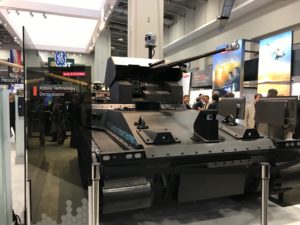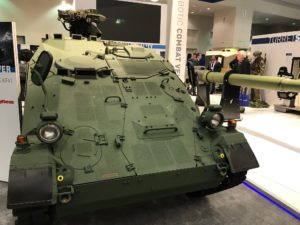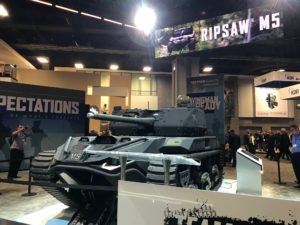The Army will release a prototype proposal request for the Robotic Combat Vehicle light and medium of variants before November and award contracts for test vehicles next spring, the lead official for the program told reporters on Monday.
The push towards the next phase of the Army’s effort to grow a robotic vehicle fleet arrives as vendors such as BAE Systems
, Germany’s Rheinmetall, as well as a team of Textron Systems [TXT], Howe & Howe and FLIR [FLR] all unveiled potential offerings at this week’s Association of the United States Army conference in Washington, D.C.

Brig. Gen. Ross Coffman, director of the Army’s Next-Generation Combat Vehicle cross-functional team, detailed plans this week for the next phase of the RCV program, which he said would “revolutionize the way [the Army] fights in the future.”
The Army will begin to solicit proposals for RCV-Light and RCV-Medium prototypes before the end of the month, with plans to hold a demonstration next March to put the platforms through a platoon-level operations experiment.
Following the demonstration, the Army will then select one vendor to build four RCV-Ls and one vendor to build four RCV-Ms, according to Coffman.
Those vehicles will then participate in a 2021 experiment going through company-level operations, before ultimately informing a 2023 decision on how the Army wants to construct its robotic vehicle fleet including the addition of an RCV-Heavy.
Coffman has said previously that RCV is intended to eventually replace soldiers in dangerous tactical situations on the future battlefield with vehicles that are payload agnostic, semi-autonomous and integrated with a range of sensors and weapon systems (Defense Daily, Aug. 22).
BAE Systems unveiled its Robotic Technology Demonstrator at AUSA, which has already participated in a recent demonstration with the Army on an outdoor test track in Sterling Heights, Michigan.
“RTD is our way to go after that leap-ahead technology. We’ve designed it as rolling lab. Our intent is to keep developing this thing. This is a test platform that allows us to keep moving ahead,” Jim Miller, BAE Systems’ senior director of business development, told reporters. “This is probably not going to be an RCV-L. It’s probably the medium and it may lead us to a heavy option if that’s where the Army continues to go.”
Miller noted RTD uses a hybrid-electric drive, is currently integrated with a 30mm gun, and contains a range of sensor suites, including a 360-degree situational awareness system and the company’s RAVEN soft-kill active protection system. The vehicle also includes a tethered UAS and a legged ground robot developed by Ghost Robotics.

Rheinmetall brought its Wiesel Wingman configured toward the RCV-L path, which combines technology from its digitized Weasel platform, in use with the German Army, and the Mission Master unmanned ground vehicle.
“That platform already exists in a digitized version. So throw out the hydraulics, the electronic kits inside, the drive-by-wire steering and electric transmission, and you combine it with the sensor and autonomy kit of the Mission Master and then you basically get a new vehicle that we call the Weasel Wingman,” Florian Reisch, director of business development and sales for Rheinmetall’s American business, told Defense Daily. Basically you combine the Weasel platform that is able to hold the autonomy kit and then you basically get what the Army is looking for with robotic combat vehicles.”
Reisch added that Rheinmetall could be interested in exploring the heavier RCV variants, listing potential options with the company’s Lynx or Marder infantry fighting vehicles.
“Of course we would be interested in the medium as well because we have different platforms available. We did have different research and development programs where we were modifying these platforms to basically enable them to carry a medium-caliber remote controlled turret. So that would be possible and we are looking at that.”
The team of Textron, Howe & Howe and FLIR showcased the Ripsaw 5 platform at AUSA. The companies said it could be scaled down for RCV-L or up to a heavier version for RCV-M.

“It’s capable for both the RCV light and the RCV medium mission sets that the Army has put forward. What this does is it optimizes the superior value, the logistics, the mission outcome. We’ve got extraordinary modularity of performance. It’s scalable with its high degree of reuse between the light and medium variants, and that just brings unmatched value to the team,” , told reporters during a teleconference last week.
Geoff Howe, senior vice president of Howe & Howe, said the company is continuing to pursue additional technology additions for Ripsaw to grow capability for the robotic vehicle while the Army assesses its needs for a future unmanned fleet.
“We are running a parallel program. Our program, we don’t stop for anything. We’re pushing forward with this technology we’ve advanced, and our plan is to meet the Army down the road with that parallel program. We’re not waiting for anybody. We’re pushing this development as far as we can,” Howe said.
QinetiQ and Pratt & Miller also announced at AUSA a new partnership to offer a variant of the Expeditionary Modular Autonomous Vehicle (EMAV) for RCV.